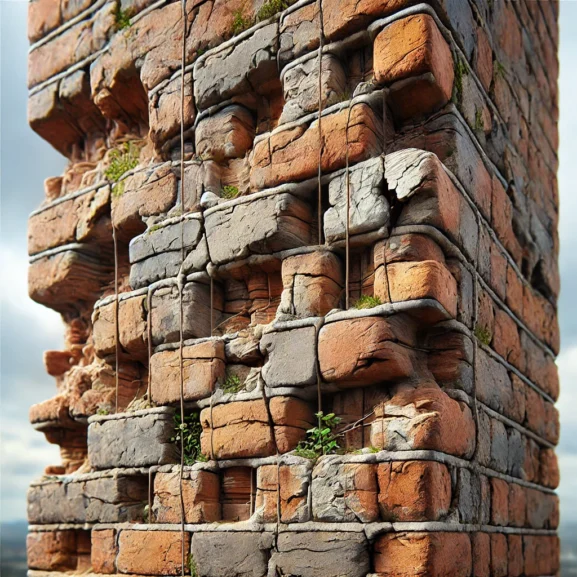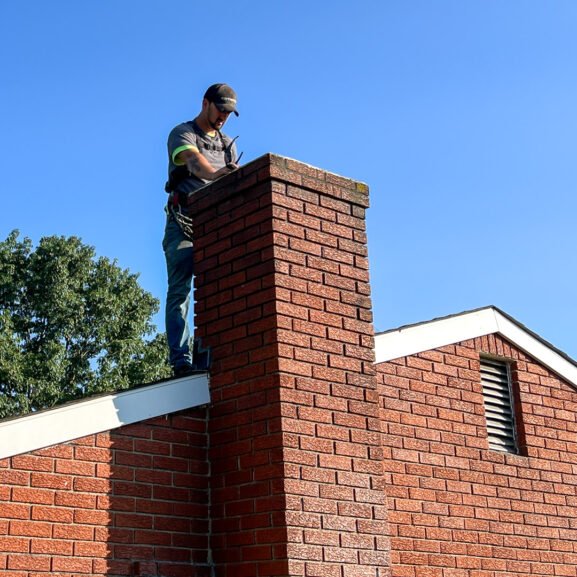Masonry Deterioration Due to Acid Rain Exposure: Causes, Signs & Prevention
We’ve all admired the timeless beauty of stone structures, but have you ever wondered about the silent enemy lurking in the rain? Acid rain is more than just an environmental concern; it’s a formidable adversary to masonry. As it falls, it gradually erodes the intricate details and strength of our cherished buildings. This process not only diminishes their aesthetic appeal but also compromises their structural integrity.
In this text, we’ll explore how acid rain accelerates masonry deterioration and what it means for the longevity of these structures. We’ll investigate into the science behind acid rain’s corrosive nature and its impact on various types of masonry materials. By understanding these effects, we can better appreciate the challenges faced by those tasked with preserving our architectural heritage. Let’s uncover the unseen battle between acid rain and masonry, and discover how we might mitigate its damaging effects.
Guide to Recognizing and Addressing Masonry Damage
Spotting masonry deterioration from acid rain saves future headaches. Acidic precipitation sneaks up, turning grand structures into crumbly messes!
- Look for Chimney Stone Erosion: Acid rain targets chimneys, causing stonework damage. Erosion manifests as rough surfaces, cracks, or missing pieces. Trusted chimney repair solutions can restore beauty.
- Check for Mortar Decay: Acid rain impacts mortar, leading to gaps between bricks. Ask us about regular maintenance that extends the life of your masonry.
- Inspect for Corrosion of Brickwork: Watch for discoloration that signals corrosion. Don’t let bricks lose the color fight!
A well-maintained chimney challenges tough weather. Protect it before it hollers “help!”
For a safe chimney, reach out to certified professionals for consultation.
Feel like a detective yet? Spotting damage is only one piece of the puzzle. We handle the rest. Be careful, DIY attempts might not always solve the problem.
For further reading, check the National Chimney Sweep Guild and Chimney Safety Institute of America for more insights. Stay savvy, and your masonry will thank you.
The Science Behind Acid Rain
Understanding acid rain helps us tackle its impact on masonry. It makes our chimneys weep, but not in the romantic way!
Causes of Acid Rain
Acid rain forms when sulfur dioxide (SO2) and nitrogen oxides (NOx) release into the atmosphere. Power plants burning fossil fuels and automobile exhaust contribute to these emissions. As these gases mix with water vapor, they turn into sulfuric and nitric acids. When it rains, these acids fall, causing the acidic precipitation known as acid rain.
Vehicles and industry are top contributors. This makes local chimneys particularly vulnerable to chimney stone erosion and brickwork corrosion. To protect your property, understand these causes. When you spot signs of masonry weathering, give us a call.
Chemical Composition and Impact
Acid rain often has a pH of 4.0, much lower than normal rain’s pH of 5.6. When this acidic precipitation strikes masonry, it reacts with minerals, leading to mortar decay and stone deterioration. The sleek stone facade you’ve cherished can soon resemble Swiss cheese!
Bricks and stones, especially limestone, are sensitive. They become porous over time, allowing water to seep within. This accelerates environmental degradation. For professional chimney repair solutions, reach out to certified professionals.
For more information, visit Environmental Protection Agency for acid rain insights or check the National Chimney Sweep Guild for maintenance tips.
Effects of Acid Rain on Masonry
Acid rain can take quite a toll on masonry, often leaving its mark as clear as, well, a gargoyle staring down. Our structures might look sturdy, but acidic precipitation is no laughing matter—except when the only joke is calling in the professionals before it’s too late.
Erosion of Surface Layer
When acid rain hits masonry, the first victim is often the surface layer. It wears away at this protective layer, leading to rough surfaces and exposed materials. This phenomenon, known as masonry weathering, is prevalent in places where environmental degradation poses a serious challenge. For example:
- Chimney stone erosion becomes evident as stones appear chipped.
- Mortar decay from acid rain results in sandy textures between the bricks.
Reach out to certified professionals for consultation before our structures start resembling Swiss cheese. For more insights on how to spot these warnings, visit Chimney Safety Institute of America.
Impact on Structural Integrity
The impact of acid rain extends deeper than just the surface. The decay can compromise the structural integrity of buildings, risking serious repairs or even total failure. Keep an eye out for:
- Corrosion of brickwork, bringing more than just a rough touch.
- Chimney stonework damage, which might leave your chimney winking at the mailman.
Maintaining our masonry takes teamwork, and the professionals play their part best. We don’t advise taking on DIYs—our chimneys deserve better! Instead, let our solutions keep things standing tall. Check out Environmental Protection Agency for more on how acid rain affects our surroundings, while we handle the rest.
For those dealing with acid attacks on masonry, reach out to certified professionals for consultation. Your chimney’s brighter days begin with us.
Identifying Signs of Deterioration
Acidic precipitation causes masonry damage that’s easy to spot if you know what to look for. Early detection helps prevent further environmental degradation and costly repairs.
Visible Damage Indicators
- Rough Textures: Acid rain wears away the smooth surface of masonry, creating a rough texture on bricks and stones.
- Cracks and Chips: Look for cracks in the mortar or chips in the stone, often a mystery only acid rain can solve!
- Discoloration: Acid rain affects bricks and stones, turning them dull or causing unsightly stains.
- Eroded Mortar: Mortar decay from acid rain might be visible if chunks are missing from joints, resembling a toothless grin.
Keeping an eye on these signs is crucial, especially in areas where chimney stonework damage is common. Spot something amiss? reach out to certified professionals for consultation.
- pH Testing: Use a pH test on affected areas. If results show acidity, it’s likely acid rain impact.
- Visual Inspection: A trained professional inspects for corrosion of brickwork and masonry weathering, which might go unnoticed by the untrained eye.
- Material Analysis: Experts can analyze stone to assess its condition and any stone deterioration, ensuring chimney repair solutions that fit the bill.
Professional inspection prevents misdiagnosis and further damage. For those brave enough to attempt DIY, remember, we don’t advise it! Trust the pros to ensure safety and reliability.
Preventive Measures and Solutions
Keep masonry structures safe from acid rain. Focus on protective coatings and smart material choices.
Protective Coatings and Sealants
Use coatings to defend masonry against acid rain impact. Sealants form a barrier that blocks acidic precipitation from penetrating. This helps prevent mortar decay from acid rain. Choose products designed for outdoor masonry to resist weathering. Consider elastomeric coatings since they offer flexibility and durability.
- Spray or Brush Application: Apply coatings uniformly.
- Regular Maintenance: Check coatings yearly for wear.
Research products at the Masonry Advisory Council for guidance on sealant options. Reach out to certified professionals for consultation.
Material Selection and Design Strategies
Select robust materials to withstand environmental degradation. Certain stones, like limestone, are more sensitive to acid rain on masonry. Opt for acid-resistant materials such as granite for chimney stonework.
- Brick Quality: Use high-density, low-porosity bricks.
- Masonry Design: Incorporate sloped surfaces to minimize water retention.
It’s crucial to partner with professionals. We’ll help you choose suitable materials and design. For the latest in chimney repair solutions, visit the Chimney Safety Institute of America.
Case Studies and Real-World Examples
Our exploration of acid rain’s impact on masonry wouldn’t be complete without real-world examples. Let’s check out some notable cases where acid rain caused significant masonry deterioration, and the remediation efforts afterward.
Historical Monuments Affected
Acid rain on masonry has left its mark on historical sites. In the US, the iconic Washington Monument faced stone deterioration due to acidic precipitation. Statues and facades lost detail as the rain eroded limestone. Some historical buildings experienced similar masonry weathering, prompting restoration efforts that continue to this day.
These examples remind us that timely intervention is crucial. If not addressed, acid rain impact leads to significant corrosion of brickwork and mortar decay. Regular inspections and professional assessments are essential to protect our heritage.
Remediation Projects
We’ve seen successful remediation projects that combat the effects of acid rain. In Ohio, a project restored a historic building using specific coatings that shield masonry from further weathering. Professionals applied protective sealants to fend off acidic precipitation, which reduced future erosion.
Local initiatives employ similar methods to safeguard structures. By choosing durable materials like granite for chimney stonework, they bolster resistance to acid rain. Regular maintenance checks ensure these measures remain effective. Remember, proper care prevents costly repairs later.
For tailored solutions and more insights, readers can explore the Environmental Protection Agency for regulatory information and the Chimney Safety Institute of America for chimney safety tips.
Conclusion
Recognizing and addressing the impact of acid rain on masonry is crucial for preserving our architectural heritage. By understanding the science behind acid rain and its effects, we can take proactive measures to protect our structures. Early detection and professional maintenance are key to preventing costly repairs and maintaining the beauty and integrity of our masonry. With the right strategies, including the use of protective coatings and acid-resistant materials, we can mitigate the damage and ensure our buildings withstand the test of time. Let’s prioritize regular inspections and seek expert guidance to safeguard our masonry against the corrosive forces of acid rain.
Frequently Asked Questions
What is acid rain, and how does it affect masonry structures?
Acid rain forms when sulfur dioxide (SO2) and nitrogen oxides (NOx) from power plants and vehicles mix with atmospheric moisture, creating precipitation with a pH of 4.0. This acidic rain can react with masonry materials, causing erosion, mortar decay, and accelerated deterioration of stone surfaces. Masonry structures, particularly those made from limestone and sandstone, become porous and weakened, compromising both aesthetic and structural integrity.
How can I identify damage caused by acid rain on masonry?
Key signs of acid rain damage include rough textures, cracks, discoloration, and eroded mortar on masonry surfaces. Regular visual inspections help in early detection, and pH testing can confirm acidity levels affecting the structure. Professional assessment is recommended for accurate identification and proper repair solutions.
What are the best strategies for preventing acid rain damage to masonry?
To protect masonry from acid rain, apply protective coatings and sealants like elastomeric coatings to form a barrier. Regular maintenance checks and the use of acid-resistant materials, such as granite, are essential preventive measures. Schedule professional inspections yearly to identify issues early and apply necessary protections.
Why should I avoid DIY repairs for acid rain-damaged masonry?
DIY repairs often lack the expertise needed to identify and address the specific effects of acid rain. Professional repair solutions ensure proper material assessment, effective restoration, and long-term protection of masonry structures. Professionals also provide tailored solutions based on a structure’s unique needs, preventing further damage and costly future repairs.
Where can I find more information about acid rain and masonry preservation?
For more information on acid rain and masonry preservation, visit the National Chimney Sweep Guild, the Chimney Safety Institute of America, and the Environmental Protection Agency. These resources offer expert insights and strategies for protecting masonry from environmental damage, including guidance on selecting proper materials and applying protective treatments.

